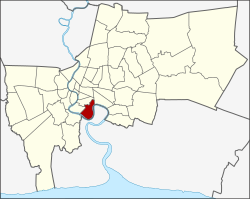Yan Nawa district
Khet in Bangkok, Thailand From Wikipedia, the free encyclopedia
Khet in Bangkok, Thailand From Wikipedia, the free encyclopedia
Yan Nawa or Yannawa (Thai: ยานนาวา, pronounced [jāːn nāːwāː]) is one of the 50 districts (khet) of Bangkok, Thailand. The district is bounded by (clockwise from west to northeast) Rat Burana (across Chao Phraya River), Bang Kho Laem, Sathon, and Khlong Toei Districts of Bangkok. Its neighbor from east to south is Phra Pradaeng district of Samut Prakan province.
Yan Nawa
ยานนาวา | |
|---|---|
 | |
 Khet location in Bangkok | |
| Coordinates: 13°41′49″N 100°32′35″E | |
| Country | Thailand |
| Province | Bangkok |
| Seat | Chong Nonsi |
| Khwaeng | 2 |
| Area | |
• Total | 16.662 km2 (6.433 sq mi) |
| Population (2017) | |
• Total | 78,797[1] |
| • Density | 4,729.14/km2 (12,248.4/sq mi) |
| Time zone | UTC+7 (ICT) |
| Postal code | 10120 |
| Geocode | 1012 |
Yan Nawa, in the past, was called Ban Thawai (Tavoy village, บ้านทะวาย)[2] or Ban Khok Khwai (water buffalo pen village, บ้านคอกควาย) due to a large concentration of Tavoy people who often brought water buffaloes to market for trade. It became Ban Thawai District during King Chulalongkorn's rule, and was part of Phra Pradaeng province. When that province was abolished in 1932, its northern parts were added to Phra Nakhon (Bangkok) Province. Ban Tavoy was then renamed Yan Nawa District in agreement with the earlier rename of Wat Ban Thawai to Wat Yan Nawa. It became a khet in 1972 and the present-day khwaeng in 1975. On 9 November 1989 parts of Yan Nawa were split off to form two new districts, Sathon and Bang Kho Laem. Wat Yan Nawa, the temple the district name inherits, is now in Sathon district.
In the past, the waters of the Chao Phraya River at Yan Nawa were influenced by rising sea level. Therefore making it a brackish water area similar to a mangrove forest. Therefore, there were many aquatic animal resources as food for the locals.
There were various species of crabs living there, including fiddler crabs and mud carbs that were usually found in edges of ditches. Most shrimp and prawn in orchard ditches were Lanchester's freshwater prawn, snapping shrimp. Yan Nawa people would turn these into dried or sweet shrimp. The large one, such as giant river prawn usually hid in nipa palm roots, could be cooked as a meat dish ands even dessert.
Lamp shell, shellfish and clams were also found living in ditches too.
The fish were also abundant. There were clown featherback, climbing perch, mullet, Java barb, black sharkminnow, mudskipper, minnow, common gourami, snakeskin gourami, walking catfish, common snakehead, sea catfish, sand goby and various species of gudgeons.
Locals would often make fishcake and green curry. Bagrid catfish was used for bamboo sprout soup. Walking catfish was the main ingredient for dried curry. For fun and entertainment, they would put wrestling halfbeak in the earthen jars or pots to fight like fighting fish.
The excess fish and shellfish could be sold in the traditional market.[3]
The district is divided into two sub-districts (khwaeng).
| No. | Name | Thai | Area (km2) | Map |
|---|---|---|---|---|
3. | Chong Nonsi | ช่องนนทรี | 9.984 |  |
4. | Bang Phongphang | บางโพงพาง | 6.678 | |
| Total | 16.662 | |||
The missing numbers 1 and 2 belong to the sub-districts which were split off to form Sathon district.
Seamless Wikipedia browsing. On steroids.
Every time you click a link to Wikipedia, Wiktionary or Wikiquote in your browser's search results, it will show the modern Wikiwand interface.
Wikiwand extension is a five stars, simple, with minimum permission required to keep your browsing private, safe and transparent.